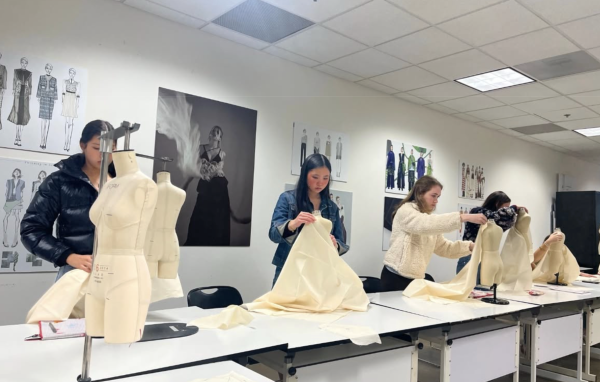Partnership between science and art promotes student understanding
Photo credit Catherine Benedict
One of the student groups taking the more hands-on approach.
Most students would agree that despite the interactive labs and excellent teaching available at Westminster, science often seems like a dry, memorization-heavy discipline. This year, teachers in science, technology, engineering, art and math are seeking to change that through participation in the STEAM PLC (professional learning community). STEAM, which is in its inaugural year, seeks to facilitate dialogue and teamwork between teachers with the goal of broadening student understanding of science through the integration of art projects into science curriculums.
Biology teacher Anna Moore is a strong believer in the importance of cross-curricular connections.
“This is the first year that I’m teaching a Neuropsychology/ Neuroanatomy class,” said Moore. “It’s a junior and senior only one semester science elective. It’s pretty dense, sophisticated material, so when planning the course I knew that project-based learning would be essential for deeper student learning. We started out the year by studying the spinal cord and central nervous system, which is really abstract concept. I placed the students into groups to design and create a sculpture emphasizing a particular region of the spinal cord.”
During a STEAM PLC meeting, Moore asked for volunteers from the art department to teach her Neuropsychology classes basic art skills. Art teacher Lauren Sleat rose to the challenge.
“I’ve always been intrigued by the myriad ways of representing the human form,” said Sleat. “I gave a presentation to Dr. Moore’s classes on alternative ways of sculpting, to encourage a paradigm shift beyond the old ‘toilet paper roll model’. I also showed some examples of contemporary artistic representations of the human body through a scientific lens.”
“My group was originally not very creative in our approach to the sculpture, but after talking to Ms. Sleat we decided to approach the project in a more visually pleasing way,” said McKenzie Parks, a junior in Neuropsychology. “Ms. Sleat and Dr. Moore really encouraged us to take an abstract approach to the process and use unconventional materials to construct our spine and highlight a certain attribute of the spine. My group chose to highlight the strength of the spine by using metal; to do this, we searched through the robotics team’s trash bin in the Robinson and came out with a few different pieces of metal to build our spine. We enlisted the help of a robotics team member to construct a metal spine. The column is a spiraled piece of metal, and the vertebrae are hollow rectangular pieces of metal. We have thin metal filaments coming out from the spine to represent nerves that extend to all parts of the body from our spine.”
It’s clear that the sculpture project cultivates not only scientific knowledge but a genuine passion for the dynamic field of neuroscience.
“By doing additional research on our group’s assigned region, we’ve gained a greater understanding of the thoracic region’s many functions,” said Lexy Rouse, a senior in Neuropsychology. “Instead of being dry information in a textbook, we have a hands-on appreciation of the spinal cord.”
Like Moore’s Neuropsychology class, Science Department Chair Chanley Small’s Human Anatomy course is also working with Sleat to further conceptual learning through art.
“A couple weeks before school started, I read an article by a non-Westminster teacher about incorporating art into a biology curriculum to more clearly illustrate concepts,” said Small. “Traditionally, Human Anatomy students have a lot of difficulty identifying different human tissue types, so I decided to adapt the activity for the class. The students chose tissue types to depict in watercolor after we did a several-day lab observing actual tissue through the microscope. Next, Ms. Sleat taught the class basic art skills, such as shading and line drawing, because a lot of my students had never taken an art class.”
The benefits of the art project were dramatic.
“Test scores after the painting project were significantly higher than in previous years,” said Small. “Almost all of the class received ‘A’s. In my opinion, the attention to detail required by the painting project caused these sometimes-abstract concepts to really ‘stick’ in the students’ heads.”
Students and teachers alike stressed that despite common perception, art and science are natural partners.
“Science and art both require a creative approach,” said Lexy Rouse, a senior in Moore’s Neuropsychology class. “Science is always changing and evolving, and it’s important for the scientist to be able to think creatively and adapt to those changes.”
“There are definitely more elements of cross-over between science and art than a lot of people realize,” said Small. “The observation skills needed to sculpt or draw are also used observing a specimen or forming a hypothesis. In addition, both art and science involve experimentation, refinement and reflection.”
The clear link between the two subjects is not a product of 21st century educational theory.
“There’s been overlap in the fields of science and art forever,” said Moore. “If you look at Leonardo da Vinci’s paintings of the human form, he’s essentially doing medical illustration.”
STEAM participants hope that the clear academic benefits caused by interdisciplinary art and science coursework will lead it to become even more prevalent at Westminster.
“There’s a linear, left-brained way of thinking, and then there’s a creative, artistic right-brained thought process,” said Sleat. “When these two merge, great things can happen.”




